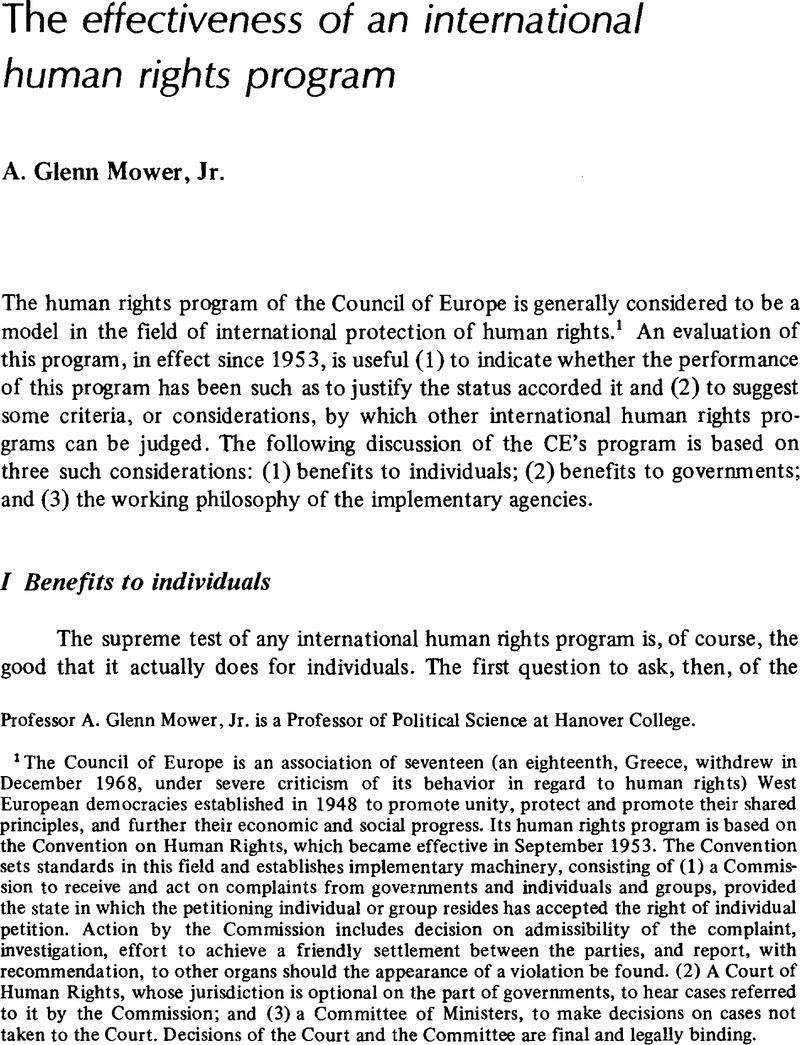Article contents
The effectiveness of an international human rights program
Published online by Cambridge University Press: 22 May 2009
Abstract

- Type
- Comments and Current Views
- Information
- Copyright
- Copyright © The IO Foundation 1975
References
1 The Council of Europe is an association of seventeen (an eighteenth, Greece, withdrew in December 1968, under severe criticism of its behavior in regard to human rights) West European democracies established in 1948 to promote unity, protect and promote their shared principles, and further their economic and social progress. Its human rights program is based on the Convention on Human Rights, which became effective in September 1953. The Convention sets standards in this field and establishes implementary machinery, consisting of (1) a Commission to receive and act on complaints from governments and individuals and groups, provided the state in which the petitioning individual or group resides has accepted the right of individual petition. Action by the Commission includes decision on admissibility of the complaint, investigation, effort to achieve a friendly settlement between the parties, and report, with recommendation, to other organs should the appearance of a violation be found. (2) A Court of Human Rights, whose jurisdiction is optional on the part of governments, to hear cases referred to it by the Commission; and (3) a Committee of Ministers, to make decisions on cases not taken to the Court. Decisions of the Court and the Committee are final and legally binding.
2 In the Commission's statistical count, this total is sometimes reduced to 44, because 76 cases represent groups of situations involving basically identical legal issues. McNulty, A. B., StockTaking on the European Convention on Human Rights, Council of Europe Doc. DH (73)8, 1 December 1973, p. 5 and 55.Google Scholar
3 Criteria include the following: all domestic remedies must have been exhausted; the statement must present an appearance of a violation (it cannot be “manifestly ill-founded”); the petition must deal with a question or situation not previously examined by the Commission or by another international agency or already submitted to another international procedure for investigation or settlement; and the petition must not be an abuse of the right of petition, incompatible with provisions of the Convention, or anonymous.
4 McNulty, p. 19ff. and 7ff.
5 The discussion in this paragraph is based on the writer's conversations with members of the European Commission.
6 Of the other eleven extradition or expulsion cases, no information was available on several, while others either withdrew their petition for help or their cases were found to involve criminal, not political considerations. There was no case of an outright refusal by a government to grant temporary or permanent relief.
7 This discussion of unofficial action by the Commission is based on the writer's conversations with Commission personnel and on Council of Europe Doc. DH/Exp. (72)12, 30 August 1972, Report of the Committee of Experts on Human Rights, Interim Measures to Supplement the European Convention on Human Rights.
8 In this connection, it is important to note that the controlling objective for the European human rights program is to achieve a higher level of human rights observance throughout the area, not to bring governments into court. The Court and its proceedings are a means to an end, not an end in themselves. The observer is tempted to see some connection between the facts that the Court ruled against defendant governments in five cases in the four-year period ending in 1971, and the greater number of successes registered more recently in efforts to achieve a friendly settlement, reflecting what some Council of Europe officials consider to be a more cooperative attitude on the part of governments.
9 An example of this is the parliamentary debate which occurred in Sweden concerning the “duty” of the government of this state to register a derogation from the European Convention's prohibition of forced or compulsory labor, in light of a Swedish act dealing with collective agreements. Yearbook of the European Convention on Human Rights (The Hague: Martinus Nijhoff, 1970), p. 1144ff.Google Scholar
10 The De Becker Case is discussed in Robertson, A. H., Human Rights in Europe (Manchester: Manchester University Press, 1963), p. 63ff.Google Scholar
11 Council of Europe, Collection of Decisions, 05 1968, p. 15ff.Google Scholar
12 This aspect of the Commission's work was mentioned by one of its officials in conversation with the writer.
13 The preceding discussion is based on conversations by the writer with Commission personnel and Council of Europe Doc. DH/Exp. (72)12, 30 August 1972, Report of the Committee of Experts on Human Rights on Interim Measures to Supplement the European Convention on Human Rights.
15 The first practice referred to above was established in the Lawless Case. In the second, the Commission was taking advantage of Rule 29 of the Court's rules of procedure, which permits the Commission's delegates before the Court to have the assistance of any person of their choice. (Strasbourg: Publications of the European Court of Human Rights: Series B: Pleadings, Oral Arguments, and Documents) 1969–1971, p. 351–7, 367.
16 Council of Europe Committee of Experts on Human Rights, Draft Report on a Short and Medium-Term Programme in the General Field of Human Rights, Recommendation 683, 15 May 1974. Council of Europe Doc. DH/Exp. (74)12, and the writer's conversations with Council of Europe personnel.
17 This position was asserted, for example, in the Cyprus and the Lawless Cases. See Robertson, , Human Rights in Europe, p. 115 and 133ff.Google Scholar
18 Human Rights in Europe, p. 133.Google Scholar
19 The twelve are: Austria, Belgium, Denmark, Federal Republic of Germany, Iceland, Ireland, Italy, Luxembourg, the Netherlands, Norway, Sweden, and the United Kingdom.
20 Draft Report on a Short and Medium-Term Programme in the General Field of Human Rights.
21 These changes were noted by the Deputy Clerk to the Court of Human Rights in conversation with the writer.
- 2
- Cited by


